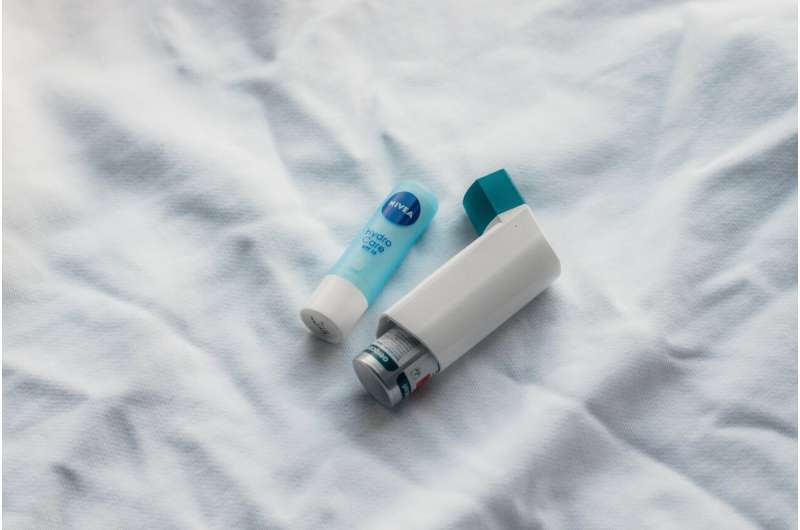This article has been reviewed according to Science X's editorial process and policies. Editors have highlighted the following attributes while ensuring the content's credibility:
fact-checked
peer-reviewed publication
trusted source
proofread
New biomarker research thaws understanding of cold-induced pediatric asthma

Many parents have long known the link between lower air temperatures and asthma flare-ups in children who suffer from the disorder. But a lack of clear science behind the link has kept many feeling left out in the cold.
New research led by Linchen He, assistant professor in the Department of Community and Population Health at Lehigh University, enlists biomarkers to help explain the connection between cold temperatures, oxidative stress and asthma flare-ups.
"Our results suggest that colder temperature exposure may increase oxidative stress in the nasal cavity, which in turn worsens asthma symptoms in children," he said. "By establishing an understanding of this pathway and an associated biomarker, these results pave the way for future research on how to effectively devise personalized pediatric asthma management strategies."
The research is published in the journal Pediatric Research.
He's team conducted a panel study involving 43 children with asthma, aged 5–13 years, over four visits, two weeks apart. They collected nasal fluid, urine and saliva samples at each visit and measured the samples for biomarkers of oxidative stress.
Oxidative stress occurs when there is an imbalance between free radicals and antioxidants in the body, leading to damage to cells, proteins and DNA. The researchers analyzed the samples for levels of malondialdehyde (MDA), a known biomarker of oxidative stress.
The body releases MDA as a byproduct of the process in which free radicals attack lipids in cell membranes. These attacks cause membranes to break down, and MDA is released into bodily fluids such as saliva, urine, and nasal fluid. Elevated levels of salivary, urinary, and nasal MDA are viewed as an indicator of increased oxidative stress in the oral cavity, circulatory system, and nasal cavity, respectively.
These measurements were cross-analyzed with the children's asthma symptoms, as measured by the Childhood Asthma Control Test (CACT). The CACT relies on symptoms reporting from both caregivers and the children themselves, and this test is widely used by clinicians to determine how well a child's asthma is controlled.
The researchers analyzed data from when outside temperatures ranged from 7 to 18°C (mid 40s to mid 60s°F). During the period, a drop in temperature of 2°C (3.6°F) was significantly associated with higher nasal MDA concentration by 47–77% and urinary MDA concentration by 6–14%.
These findings align with a prior study that found colder temperature exposure could damage the interior lining of the nose, resulting in increased inflammation and diminished immunity to infectious bacteria and viruses in the nasal cavity. The elevated inflammatory response in the nasal cavity could generate free radicals that can damage lipids and proteins, leading to higher nasal oxidative stress.
In addition, the researchers' statistical analyses concluded that nasal MDA partially mediated, or explained, 14–57% of the associations between colder temperature exposure and worsened child-reported CACT scores. The results suggest that higher oxidative stress in the nasal cavity may trigger mucosal irritation in the lower airway, leading to respiratory symptoms.
The authors also mentioned that the nasal cavity is also the primary portal for air pollutants to enter the human body. Their previous research reported that higher air pollutant exposures were also significantly associated with higher nasal MDA levels. The findings of the previous and current studies indicate that nasal MDA is a sensitive biomarker to these asthma triggers.
They cautioned that "more effort is warranted to understand how to effectively incorporate this biomarker into personalized pediatric asthma management strategies."
He also stressed that the results of the current study are limited based on its sample size, unmeasured environmental exposures (e.g., aeroallergens), and limited variation in temperature exposure during the study period.
"Further research is recommended to confirm these findings and explore potential mechanisms underlying the association between temperature exposure, oxidative stress and asthma exacerbation," He said.
The findings represent an important step in the process of understanding and enhancing treatments for pediatric asthma.
More information: Linchen He et al, Nasal oxidative stress mediating the effects of colder temperature exposure on pediatric asthma symptoms, Pediatric Research (2024). DOI: 10.1038/s41390-024-03196-2




















